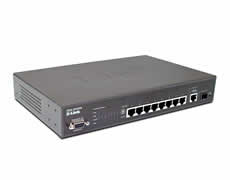D-Link DES-3010PA Managed PoE Switch
D-Link Updated: 2008-10-05 RSS
With a 5.6Gbps switching capacity and Power-over-Ethernet (PoE), D-Link® DES-3010PA is a high-performance managed Layer 2 solution that provides an ideal choice for workgroups and departments needing advanced Layer 2 switching features in a small form factor 11” chassis. The DES-3010PA is a great entry-level switch for the SMB just starting out or the already established business looking to bring a managed solution to the desktop. The optional fiber uplink can provide connectivity for a small group of users over a larger distance such as on a campus or between indoor classrooms. The DES-3010PA has eight 10/100Mbps Fast Ethernet ports and an SFP port for high-speed uplinks to servers and/or backbones. In addition the DES-3010PA is also equipped with a copper 1000Base-T port for easy uplinks to standard Gigabit copper switches. Finally, with support for Power-over-Ethernet on all eight ports, the DES-3010PA is capable of supporting IEEE 802.3af enabled access points, security cameras, IP phones and more without the need for additional wiring.
High-Performance Layer 2 Switching
With a 5.6Gbps switching capacity, the DES-3010PA is a wire-speed, high performance switch. It includes support for Private VLANs (for isolating ports to protect privacy), and Guest VLANs. Guest VLANs are useful when migrating end users to an 802.1x environment when existing workstations do not yet support the 802.1x protocol, and for delivering limited services such as Internet access to un-authenticated and short-term users. When deployed in a school campus, bookstore, coffee house, or other retail establishment, the DES-3010PA can be used in conjunction with wireless access points to create a secure Internet Hotspot. This allows visitors to access special services or surf the Internet completely isolated from sensitive internal network data. And with the addition of up to 15.4 watts of PoE per port, powering those wireless access points has never been easier.
Advanced Enterprise Features
The DES-3010PA brings advanced enterprise functions to a more affordable level while supporting advanced features: QoS/CoS based on 802.1p, Port, DSCP and ToS, rich security and management features such as 802.1x port and MAC based RADIUS and TACACS+ authentication, secure encrypted management through both SSH and SSL, guest and private VLANs, bandwidth control, and SNMP versions 1/2c/3. The DES-3010PA also supports many of the features you would expect to see on a larger managed solution such as: IGMP snooping, IEEE802.3ad (Link Aggregation), 256 VLANs, support for GVRP, traffic monitoring, SYSLOG, and more.
IEEE 802.3af Power over Ethernet
The DES-3010PA supports eight ports of IEEE 802.3af (PoE) and supplies up to 15.4 watts per port to power any 802.3af compliant power device. The need for PoE-enabled switching devices is growing as the industry continues to produce PoE capable access points, IP phones, security cameras, PDA cradles, and more. The difficulty and cost often associated with running new AC power outlets to difficult to reach locations has made PoE an indespensable technology for SMBs, Schools, and Enterprise class networks. For devices that are not IEEE 802.3af compliant, the D-Link DWL-P50 adapter can be used to supply power to the device making it fully compatible with the DES-3010PA.
Advanced Power Management
The DES-3010PA includes advanced PoE power management capabilities not found in unmanaged PoE solutions. These features include individual port status monitoring, fast power shutdown (in the case of power supply failure) and voltage/ current monitoring and regulation. Power management allows the DES-3010PA to determine the exact power draw per port and to balance each port's PoE power output accordingly. This in turn allows the switch to power higher and lower wattage devices according to user-definable parameters such as: maximum available power, port priority (critical, high, low), and maximum allowable power per port. To further assist the user in status and troubleshooting, the user can view the following statistics from the CLI or GUI at any remote location within the network: Powered Device (PD) classification, Status and detection of the PD, Power status monitoring (actual power usage and percentage used), and counters to measure shorts and overloads.
Owners Manual
Data Sheet
Related Manuals
D-Link DES-3828P Managed Stackable Switch
D-Link DES-1316 Web Smart Switch
D-Link DES-1228P Web Smart Switch
D-Link DES-3252P Web Smart PoE Switch
D-Link DWS-1008 Wireless Switch
D-Link DWL-P1012 PoE Midspan
D-Link DHP-300 PowerLine HD Ethernet Adapter
D-Link DHP-301 PowerLine HD Network Starter Kit
D-Link DES-1105 Desktop Switch
D-Link DES-1108 Desktop Switch
D-Link DES-1008PA Desktop Switch
D-Link DSS-16+ Desktop Switch